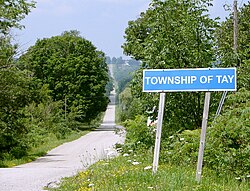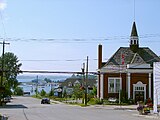Tay, Ontario
Tay | |
|---|---|
| Township of Tay | |
 | |
| Coordinates: 44°43′N 79°46′W / 44.717°N 79.767°W | |
| Country | Canada |
| Province | Ontario |
| County | Simcoe |
| Incorporated | 1994 |
| Government | |
| • Mayor | Ted Walker |
| • MPs | Bruce Stanton |
| • MPPs | Jill Dunlop |
| Area | |
| • Land | 137.86 km2 (53.23 sq mi) |
| Population (2021)[1] | |
| • Total | 11,091 |
| • Density | 80.5/km2 (208/sq mi) |
| Time zone | UTC-5 (Eastern (EST)) |
| • Summer (DST) | UTC-4 (EDT) |
| Area code(s) | 705, 249 |
| Website | www |
Tay is a township in Central Ontario, Canada, located in Simcoe County in the southern Georgian Bay region. The township was named in 1822 after a pet dog of Lady Sarah Maitland (1792–1873), wife of Sir Peregrine Maitland, Lieutenant Governor of Upper Canada. Two other adjoining townships were also named for her pet dogs, Tiny and Flos (now Springwater Township).[2]
History
[edit]The current territory of Tay was home to the Wendat towns of Teanaostataé (St. Louis), and Taenhatentaron (St. Ignace). Together with the nearby town of Teanaustayé (St. Joseph) in nearby Hillsdale they were destroyed by the Iroquois (Haudenosaunee) in 1648–1649. During this warfare, the Jesuits Jean de Brébeuf and Gabriel Lalemant were killed at Taenhatentaron.[3]
In 1994, under countywide municipal restructuring, the Villages of Port McNicoll and Victoria Harbour were amalgamated with Tay.
Communities
[edit]The township comprises the villages and rural hamlets of Ebenezer, Elliots Corners, Melduf, Mertzs Corners, Ogden's Beach, Old Fort, Paradise Point, Port McNicoll, Riverside, Sturgeon Bay, Triple Bay Park, Vasey, Victoria Harbour, Waubaushene and Waverley.
-
Port McNicoll
-
Victoria Harbour
Demographics
[edit]In the 2021 Census of Population conducted by Statistics Canada, Tay had a population of 11,091 living in 4,535 of its 5,301 total private dwellings, a change of 10.5% from its 2016 population of 10,033. With a land area of 137.86 km2 (53.23 sq mi), it had a population density of 80.5/km2 (208.4/sq mi) in 2021.[1]
| 2021 | 2016 | 2011 | |
|---|---|---|---|
| Population | 11,091 (+10.5% from 2016) | 10,033 (+3.1% from 2011) | 9,736 (-0.1% from 2006) |
| Land area | 137.86 km2 (53.23 sq mi) | 139.07 km2 (53.70 sq mi) | 139.00 km2 (53.67 sq mi) |
| Population density | 80.5/km2 (208/sq mi) | 72.1/km2 (187/sq mi) | 70.0/km2 (181/sq mi) |
| Median age | 49.2 (M: 48.4, F: 50.0) | 48.7 (M: 47.9, F: 49.4) | |
| Private dwellings | 5,301 (total) 4,535 (occupied) | 4,931 (total) | 5,049 (total) |
| Median household income | $82,000 | $65,190 |
| Year | Pop. | ±% |
|---|---|---|
| 1996 | 9,044 | — |
| 2001 | 9,162 | +1.3% |
| 2006 | 9,748 | +6.4% |
| 2011 | 9,736 | −0.1% |
| 2016 | 10,033 | +3.1% |
| 2021 | 11,091 | +10.5% |
| Population counts are not adjusted for boundary changes. Source: Statistics Canada | ||
Notable people
[edit]- Amos Arbour - NHL, NHA hockey player, member of original Montreal Canadiens hockey club.
- Wayne Middaugh - World Champion Curling Skip
- Sherry Middaugh - Canadian Curling Skip
- Keith Waples - Famed driver of Standardbred horses and inductee into Canada's Sports Hall of Fame
See also
[edit]References
[edit]- ^ a b c "Tay, Ontario (Code 3543071) Census Profile". 2021 census. Government of Canada - Statistics Canada. Retrieved 2024-09-27.
- ^ Rayburn, Alan (1997), Place Names of Ontario (University of Toronto Press), Toronto-Buffalo-London, ISBN 0-8020-7207-0), pp.345
- ^ "Culmination of Iroquoian Wars: Sainte Marie I Destruction". Digital Museums Canada. Retrieved November 19, 2023.
- ^ "2021 Community Profiles". 2021 Canadian census. Statistics Canada. February 4, 2022. Retrieved 2024-09-27.
- ^ "2016 Community Profiles". 2016 Canadian census. Statistics Canada. August 12, 2021. Retrieved 2017-08-15.
- ^ "2011 Community Profiles". 2011 Canadian census. Statistics Canada. March 21, 2019. Retrieved 2012-02-15.
- ^ "2006 Community Profiles". 2006 Canadian census. Statistics Canada. August 20, 2019.
- ^ "2001 Community Profiles". 2001 Canadian census. Statistics Canada. July 18, 2021.




